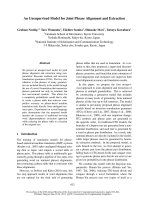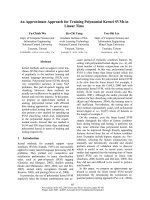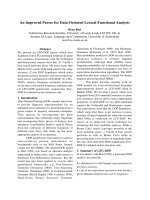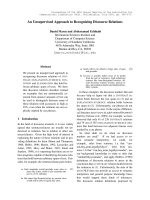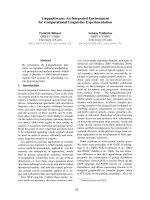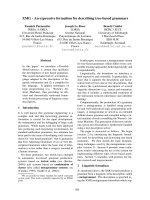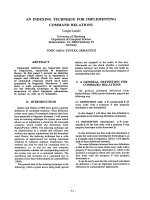Báo cáo khoa học: "An Unsupervised System for Identifying English Inclusions in German Text" doc
Bạn đang xem bản rút gọn của tài liệu. Xem và tải ngay bản đầy đủ của tài liệu tại đây (78.04 KB, 6 trang )
Proceedings of the ACL Student Research Workshop, pages 133–138,
Ann Arbor, Michigan, June 2005.
c
2005 Association for Computational Linguistics
An Unsupervised System for Identifying English Inclusions in German Text
Beatrice Alex
School of Informatics
University of Edinburgh
Edinburgh, EH8 9LW, UK
Abstract
We present an unsupervised system that
exploits linguistic knowledge resources,
namely English and German lexical
databases and the World Wide Web, to
identify English inclusions in German
text. We describe experiments with this
system and the corpus which was devel-
oped for this task. We report the classifi-
cation results of our system and compare
them to the performance of a trained ma-
chine learner in a series of in- and cross-
domain experiments.
1 Introduction
The recognition of foreign words and foreign named
entities (NEs) in otherwise mono-lingual text is be-
yond the capability of many existing approaches and
is only starting to be addressed. This language mix-
ing phenomenon is prevalent in German where the
number of anglicisms has increased considerably.
We have developed an unsupervised and highly
efficient system that identifies English inclusions
in German text by means of a computationally in-
expensive lookup procedure. By unsupervised we
mean that the system does not require any anno-
tated training data and only relies on lexicons and
the Web. Our system allows linguists and lexicogra-
phers to observe language changes over time, and to
investigate the use and frequency of foreign words
in a given language and domain. The output also
represents valuable information for a number of ap-
plications, including polyglot text-to-speech (TTS)
synthesis and machine translation (MT).
We will first explain the issue of foreign inclu-
sions in German text in greater detail with exam-
ples in Section 2. Sections 3 and 4 describe the data
we used and the architecture of our system. In Sec-
tion 5, we provide an evaluation of the system out-
put and compare the results with those of a series of
in- and cross-domain machine learning experiments
outlined in Section 6. We conclude and outline fu-
ture work in Section 7.
2 Motivation
In natural language, new inclusions typically fall
into two major categories, foreign words and proper
nouns. They cause substantial problems for NLP ap-
plications because they are hard to process and infi-
nite in number. It is difficult to predict which for-
eign words will enter a language, let alone create an
exhaustive gazetteer of them. In German, there is
frequent exposure to documents containing English
expressions in business, science and technology, ad-
vertising and other sectors. A look at current head-
lines confirms the existence of this phenomenon:
(1) “Security-Tool verhindert, dass Hacker ¨uber
Google Sicherheitsl¨ucken finden”
1
Security tool prevents hackers from finding
security holes via Google.
An automatic classifier of foreign inclusions would
prove valuable for linguists and lexicographers who
1
Published in Computerwelt on 10/01/2005:
133
study this language-mixing phenomenon because
lexical resources need to be updated and reflect this
trend. As foreign inclusions carry critical content in
terms of pronunciation and semantics, their correct
recognition will also provide vital knowledge in ap-
plications such as polyglot TTS synthesis or MT.
3 Data
Our corpus is made up of a random selection of
online German newspaper articles published in the
Frankfurter Allgemeine Zeitung between 2001 and
2004 in the domains of (1) internet & telecomms,
(2) space travel and (3) European Union. These do-
mains were chosen to examine the different use and
frequency of English inclusions in German texts of
a more technological, scientific and political nature.
With approximately 16,000 tokens per domain, the
overall corpus comprises of 48,000 tokens (Table 1).
We created a manually annotated gold standard
using an annotation tool based on NITE XML (Car-
letta et al., 2003). We annotated two classes whereby
English words and abbreviations that expand to En-
glish terms were classed as “English” (EN) and all
other tokens as “Outside” (O).
2
Table 1 presents the
number of English inclusions annotated in each gold
standard set and illustrates that English inclusions
are very sparse in the EU domain (49 tokens) but
considerably frequent in the documents in the inter-
net and space travel domains (963 and 485 tokens,
respectively). The type-token ratio (TTR) signals
that the English inclusions in the space travel data
are less diverse than those in the internet data.
Domain Tokens Types TTR
Internet Total 15919 4152 0.26
English 963 283 0.29
Space Total 16066 3938 0.25
English 485 73 0.15
EU Total 16028 4048 0.25
English 49 30 0.61
Table 1: English token and type statistics and type-
token-ratios (TTR) in the gold standard
2
We did not annotate English inclusions if part of URLs
(www.stepstone.de), mixed-lingual unhyphenated compounds
(Shuttleflug) or with German inflections (Receivern) as further
morphological analysis is required to recognise them. Our aim
is to address these issues in future work.
4 System Description
Our system is a UNIX pipeline which converts
HTML documents to XML and applies a set of mod-
ules to add linguistic markup and to classify nouns
as German or English. The pipeline is composed of
a pre-processing module for tokenisation and POS-
tagging as well as a lexicon lookup and Google
lookup module for identifying English inclusions.
4.1 Pre-processing Module
In the pre-processing module, the downloaded Web
documents are firstly cleaned up using Tidy
3
to
remove HTML markup and any non-textual in-
formation and then converted into XML. Subse-
quently, two rule-based grammars which we devel-
oped specifically for German are used to tokenise the
XML documents. The grammar rules are applied
with lxtransduce
4
, a transducer which adds or
rewrites XML markup on the basis of the rules pro-
vided. Lxtransduce is an updated version of
fsgmatch, the core program of LT TTT (Grover
et al., 2000). The tokenised text is then POS-tagged
using TnT trained on the German newspaper corpus
Negra (Brants, 2000).
4.2 Lexicon Lookup Module
For the initial lookup, we used CELEX, a lexical
database of English, German and Dutch containing
full and inflected word forms as well as correspond-
ing lemmas. CELEX lookup was only performed
for tokens which TnT tagged as nouns (NN), for-
eign material (FM) or named entities (NE) since
anglicisms representing other parts of speech are
relatively infrequent in German (Yeandle, 2001).
Tokens were looked up twice, in the German and
the English database and parts of hyphenated com-
pounds were checked individually. To identify cap-
italised English tokens, the lookup in the English
database was made case-insensitive. We also made
the lexicon lookup sensitive to POS tags to reduce
classification errors. Tokens were found either only
in the German lexicon (1), only in the English lexi-
con (2) in both (3) or in neither lexicon (4).
(1) The majority of tokens found exclusively in
3
4
/>lxtransduce.html
134
the German lexicon are actual German words. The
remaining are English words with German case in-
flection such as Computern. The word Computer
is used so frequently in German that it already ap-
pears in lexicons and dictionaries. To detect the base
language of the latter, a second lookup can be per-
formed checking whether the lemma of the token
also occurs in the English lexicon.
(2) Tokens found exclusively in the English lexi-
con such as Software or News are generally English
words and do not overlap with German lexicon en-
tries. These tokens are clear instances of foreign in-
clusions and consequently tagged as English.
(3) Tokens which are found in both lexicons are
words with the same orthographic characteristics in
both languages. These are words without inflec-
tional endings or words ending in s signalling ei-
ther the German genitive singular or the German and
English plural forms of that token, e.g. Computers.
The majority of these lexical items have the same
or similar semantics in both languages and represent
assimilated loans and cognates where the language
origin is not always immediately apparent. Only
a small subgroup of them are clearly English loan
words (e.g. Monster). Some tokens found in both
lexicons are interlingual homographs with different
semantics in the two languages, e.g. Rat (council vs.
rat). Deeper semantic analysis is required to classify
the language of such homographs which we tagged
as German by default.
(4) All tokens found in neither lexicon are submit-
ted to the Google lookup module.
4.3 Google Lookup Module
The Google lookup module exploits the World Wide
Web, a continuously expanding resource with docu-
ments in a multiplicity of languages. Although the
bulk of information available on the Web is in En-
glish, the number of texts written in languages other
than English has increased rapidly in recent years
(Crystal, 2001; Grefenstette and Nioche, 2000).
The exploitation of the Web as a linguistic cor-
pus is developing into a growing trend in compu-
tational linguistics. The sheer size of the Web and
the continuous addition of new material in different
languages make it a valuable pool of information in
terms of language in use. The Web has already been
used successfully for a series of NLP tasks such as
MT (Grefenstette, 1999), word sense disambigua-
tion (Agirre and Martinez, 2000), synonym recogni-
tion (Turney, 2001), anaphora resolution (Modjeska
et al., 2003) and determining frequencies for unseen
bi-grams (Keller and Lapata, 2003).
The Google lookup module obtains the number
of hits for two searches per token, one on German
Web pages and one on English ones, an advanced
language preference offered by Google. Each token
is classified as either German or English based on
the search that returns the higher normalised score
of the number of hits. This score is determined by
weighting the number of raw hits by the size of the
Web corpus for that language. We determine the lat-
ter following a method proposed by Grefenstette and
Niochi (2000) by using the frequencies of a series of
representative tokens within a standard corpus in a
language to determine the size of the Web corpus
for that language. We assume that a German word is
more frequently used in German text than in English
and vice versa. As illustrated in Table 2, the Ger-
man word Anbieter (provider) has a considerably
higher weighted frequency in German Web docu-
ments (DE). Conversely, the English word provider
occurs more often in English Web documents (EN).
If both searches return zero hits, the token is classi-
fied as German by default. Word queries that return
zero or a low number of hits can also be indicative
of new expressions that have entered a language.
Google lookup was only performed for the tokens
found in neither lexicon in order to keep computa-
tional cost to a minimum. Moreover, a preliminary
experiment showed that the lexicon lookup is al-
ready sufficiently accurate for tokens contained ex-
clusively in the German or English databases. Cur-
rent Google search options are also limited in that
queries cannot be treated case- or POS-sensitively.
Consequently, interlingual homographs would often
mistakenly be classified as English.
Language DE EN
Hits Raw Normalised Raw Normalised
Anbieter 3.05 0.002398 0.04 0.000014
Provider 0.98 0.000760 6.42 0.002284
Table 2: Raw counts (in million) and normalised
counts of two Google lookup examples
135
5 Evaluation of the Lookup System
We evaluated the system’s performance for all to-
kens against the gold standard. While the accuracies
in Table 3 represent the percentage of all correctly
tagged tokens, the F-scores refer to the English to-
kens and are calculated giving equal weight to preci-
sion (P) and recall (R) as
.
The system yields relatively high F-scores of 72.4
and 73.1 for the internet and space travel data but
only a low F-score of 38.6 for the EU data. The lat-
ter is due to the sparseness of English inclusions in
that domain (Table 1). Although recall for this data
is comparable to that of the other two domains, the
number of false positives is high, causing low pre-
cision and F-score. As the system does not look up
one-character tokens, we implemented further post-
processing to classify individual characters as En-
glish if followed by a hyphen and an English inclu-
sion. This improves the F-score by 4.8 for the inter-
net data to 77.2 and by 0.6 for the space travel data to
73.7 as both data sets contain words like E-Mail or
E-Business. Post-processing does not decrease the
EU score. This indicates that domain-specific post-
processing can improve performance.
Baseline accuracies when assuming that all to-
kens are German are also listed in Table 3. As F-
scores are calculated based on the English tokens
in the gold standard, we cannot report comparable
baseline F-scores. Unsurprisingly, the baseline ac-
curacies are relatively high as most tokens in a Ger-
man text are German and the amount of foreign ma-
terial is relatively small. The added classification of
English inclusions yielded highly statistical signif-
icant improvements (p
0.001) over the baseline of
3.5% for the internet data and 1.5% for the space
travel data. When classifying English inclusions in
the EU data, accuracy decreased slightly by 0.3%.
Table 3 also shows the performance of TextCat,
an n-gram-based text categorisation algorithm of
Cavnar and Trenkle (1994). While this language
idenfication tool requires no lexicons, its F-scores
are low for all 3 domains and very poor for the EU
data. This confirms that the identification of English
inclusions is more difficult for this domain, coincid-
ing with the result of the lookup system. The low
scores also prove that such language identification is
unsuitable for token-based language classification.
Domain Method Accuracy F-score
Internet Baseline 94.0% -
Lookup 97.1% 72.4
Lookup + post 97.5% 77.2
TextCat 92.2% 31.0
Space Baseline 97.0% -
Lookup 98.5% 73.1
Lookup + post 98.5% 73.7
TextCat 93.8% 26.7
EU Baseline 99.7% -
Lookup 99.4% 38.6
Lookup + post 99.4% 38.6
TextCat 96.4% 4.7
Table 3: Lookup results (with and without post-
processing) compared to TextCat and baseline
6 Machine Learning Experiments
The recognition of foreign inclusions bears great
similarity to classification tasks such as named en-
tity recognition (NER), for which various machine
learning techniques have proved successful. We
were therefore interested in determining the perfor-
mance of a trained classifier for our task. We ex-
perimented with a conditional Markov model tagger
that performed well on language-independent NER
(Klein et al., 2003) and the identification of gene and
protein names (Finkel et al., 2005).
6.1 In-domain Experiments
We performed several 10-fold cross-validation ex-
periments with different feature sets. They are re-
ferred to as in-domain (ID) experiments as the tagger
is trained and tested on data from the same domain
(Table 4). In the first experiment (ID1), we use the
tagger’s standard feature set including words, char-
acter sub-strings, word shapes, POS-tags, abbrevi-
ations and NE tags (Finkel et al., 2005). The re-
sulting F-scores are high for the internet and space
travel data (84.3 and 91.4) but are extremely low for
the EU data (13.3) due to the sparseness of English
inclusions in that data set. ID2 involves the same
setup as ID1 but eliminating all features relying on
the POS-tags. The tagger performs similarly well
for the internet and space travel data but improves
by 8 points to an F-score of 21.3 for the EU data.
This can be attributed to the fact that the POS-tagger
136
does not perform with perfect accuracy particularly
on data containing foreign inclusions. Providing the
tagger with this information is therefore not neces-
sarily useful for this task, especially when the data
is sparse. Nevertheless, there is a big discrepancy
between the F-score for the EU data and those of the
other two data sets. ID3 and ID4 are set up as ID1
and ID2 but incorporating the output of the lookup
system as a gazetteer feature. The tagger benefits
considerably from this lookup feature and yields bet-
ter F-scores for all three domains in ID3 (internet:
90.6, space travel: 93.7, EU: 44.4).
Table 4 also compares the best F-scores produced
with the tagger’s own feature set (ID2) to the best
results of the lookup system and the baseline. While
the tagger performs much better for the internet
and the space travel data, it requires hand-annotated
training data. The lookup system, on the other hand,
is essentially unsupervised and therefore much more
portable to new domains. Given the necessary lexi-
cons, it can easily be run over new text and text in a
different language or domain without further cost.
6.2 Cross-domain Experiments
The tagger achieved surprisingly high F-scores for
the internet and space travel data, considering the
small training data set of around 700 sentences used
for each ID experiment described above. Although
both domains contain a large number of English in-
clusions, their type-token ratio amounts to 0.29 in
the internet data and 0.15 in the space travel data
(Table 1), signalling that English inclusions are fre-
quently repeated in both domains. As a result, the
likelihood of the tagger encountering an unknown
inclusion in the test data is relatively small.
To examine the tagger’s performance on a new do-
main containing more unknown inclusions, we ran
two cross-domain (CD) experiments: CD1, train-
ing on the internet and testing on the space travel
data, and CD2, training on the space travel and test-
ing on the internet data. We chose these two do-
main pairs to ensure that both the training and test
data contain a relatively large number of English in-
clusions. Table 5 shows that the F-scores for both
CD experiments are much lower than those obtained
when training and testing the tagger on documents
from the same domain. In experiment CD1, the F-
score only amounts to 54.2 while the percentage of
Domain Accuracy F-score
Internet ID1 98.4% 84.3
ID2 98.3% 84.3
ID3 98.9% 90.6
ID4 98.9% 90.8
Best Lookup 97.5% 77.2
Baseline 94.0% -
Space ID1 99.5% 91.4
ID2 99.5% 91.3
ID3 99.6% 93.7
ID4 99.6% 92.8
Best Lookup 98.5% 73.7
Baseline 97.0% -
EU ID1 99.7% 13.3
ID2 99.7% 21.3
ID3 99.8% 44.4
ID4 99.8% 44.4
Best Lookup 99.4% 38.6
Baseline 99.7% -
Table 4: Accuracies and F-scores for ID experiments
Accuracy F-score UTT
CD1 97.9% 54.2 81.9%
Best Lookup 98.5% 73.7 -
Baseline 97.0% - -
CD2 94.6% 22.2 93.9%
Best Lookup 97.5% 77.2 -
Baseline 94.0% - -
Table 5: Accuracies, F-scores and percentages of
unknown target types (UTT) for cross-domain ex-
periments compared to best lookup and baseline
unknown target types in the space travel test data is
81.9%. The F-score is even lower in the second ex-
periment at 22.2 which can be attributed to the fact
that the percentage of unknown target types in the
internet test data is higher still at 93.9%.
These results indicate that the tagger’s high per-
formance in the ID experiments is largely due to the
fact that the English inclusions in the test data are
known, i.e. the tagger learns a lexicon. It is there-
fore more complex to train a machine learning clas-
sifier to perform well on new data with more and
more new anglicisms entering German over time.
The amount of unknown tokens will increase con-
stantly unless new annotated training data is added.
137
7 Conclusions and Future Work
We have presented an unsupervised system that ex-
ploits linguistic knowledge resources including lex-
icons and the Web to classify English inclusions in
German text on different domains. Our system can
be applied to new texts and domains with little com-
putational cost and extended to new languages as
long as lexical resources are available. Its main ad-
vantage is that no annotated training data is required.
The evaluation showed that our system performs
well on non-sparse data sets. While being out-
performed by a machine learner which requires
a trained model and therefore manually annotated
data, the output of our system increases the per-
formance of the learner when incorporating this in-
formation as an additional feature. Combining sta-
tistical approaches with methods that use linguistic
knowledge resources can therefore be advantageous.
The low results obtained in the CD experiments
indicate however that the machine learner merely
learns a lexicon of the English inclusions encoun-
tered in the training data and is unable to classify
many unknown inclusions in the test data. The
Google lookup module implemented in our system
represents a first attempt to overcome this problem
as the information on the Web never remains static
and at least to some extent reflects language in use.
The current system tracks full English word
forms. In future work, we aim to extend it to iden-
tify English inclusions within mixed-lingual tokens.
These are words containing morphemes from dif-
ferent languages, e.g. English words with German
inflection (Receivern) or mixed-lingual compounds
(Shuttleflug). We will also test the hypothesis that
automatic classification of English inclusions can
improve text-to-speech synthesis quality.
Acknowledgements
Thanks go to Claire Grover and Frank Keller for
their input. This research is supported by grants
from the University of Edinburgh, Scottish Enter-
prise Edinburgh-Stanford Link (R36759) and ESRC.
References
Eneko Agirre and David Martinez. 2000. Exploring au-
tomatic word sense disambiguation with decision lists
and the Web. In Proceedings of the Semantic Annota-
tion and Intelligent Annotation workshop, COLING.
Thorsten Brants. 2000. TnT – a statistical part-of-speech
tagger. In Proceedings of the6th Applied Natural Lan-
guage Processing Conference.
Jean Carletta, Stefan Evert, Ulrich Heid, Jonathan Kil-
gour, Judy Robertson, and Holgar Voormann. 2003.
The NITE XML toolkit: flexible annotation for multi-
modal language data. Behavior Research Methods, In-
struments, and Computers, 35(3):353–363.
William B. Cavnar and John M. Trenkle. 1994. N-gram-
based text categorization. In Proceedings of the 3rd
Annual Symposium on Document Analysis and Infor-
mation Retrieval.
David Crystal. 2001. Language and the Internet. Cam-
bridge University Press.
Jenny Finkel, Shipra Dingare, Christopher Manning,
Malvina Nissim, Beatrice Alex, and Claire Grover.
2005. Exploring the boundaries: Gene and protein
identification in biomedical text. BMC Bioinformat-
ics. In press.
Gregory Grefenstette and Julien Nioche. 2000. Estima-
tion of English and non-English language use on the
WWW. In Proceedings of RIAO 2000.
Gregory Grefenstette. 1999. The WWW as a resource
for example-based machine translation tasks. In Pro-
ceedings of ASLIB’99 Translating and the Computer.
Claire Grover, Colin Matheson, Andrei Mikheev, and
Moens Marc. 2000. LT TTT - a flexible tokenisation
tool. In Proceedings of the 2nd International Confer-
ence on Language Resources and Evaluation.
Frank Keller andMirella Lapata. 2003. Using the Webto
obtain frequenciesforunseen bigrams. Computational
Linguistics, 29(3):458–484.
Dan Klein, Joseph Smarr, Huy Nguyen, and Christo-
pher D. Manning. 2003. Named entity recognition
with character-level models. In Proceedings of the 7th
Conference on Natural Language Learning.
Natalia Modjeska, Katja Markert, and Malvina Nissim.
2003. Using the Web in machine learning for other-
anaphora resolution. In Proceedings of the Conference
on Empirical Methods in Natural Language Process-
ing.
Peter D. Turney. 2001. Mining the Web for synonyms:
PMI-IR versus LSA on TOEFL. In Proceedings of the
12th European Conference on Machine Learning.
David Yeandle. 2001. Types of borrowing of Anglo-
American computing terminology in German. In
Marie C. Davies, John L. Flood, and David N. Yean-
dle, editors, Proper Words in Proper Places: Studies
in Lexicology and Lexicography in Honour of William
Jervis Jones, pages 334–360. Stuttgarter Arbeiten zur
Germanistik 400, Stuttgart, Germany.
138
